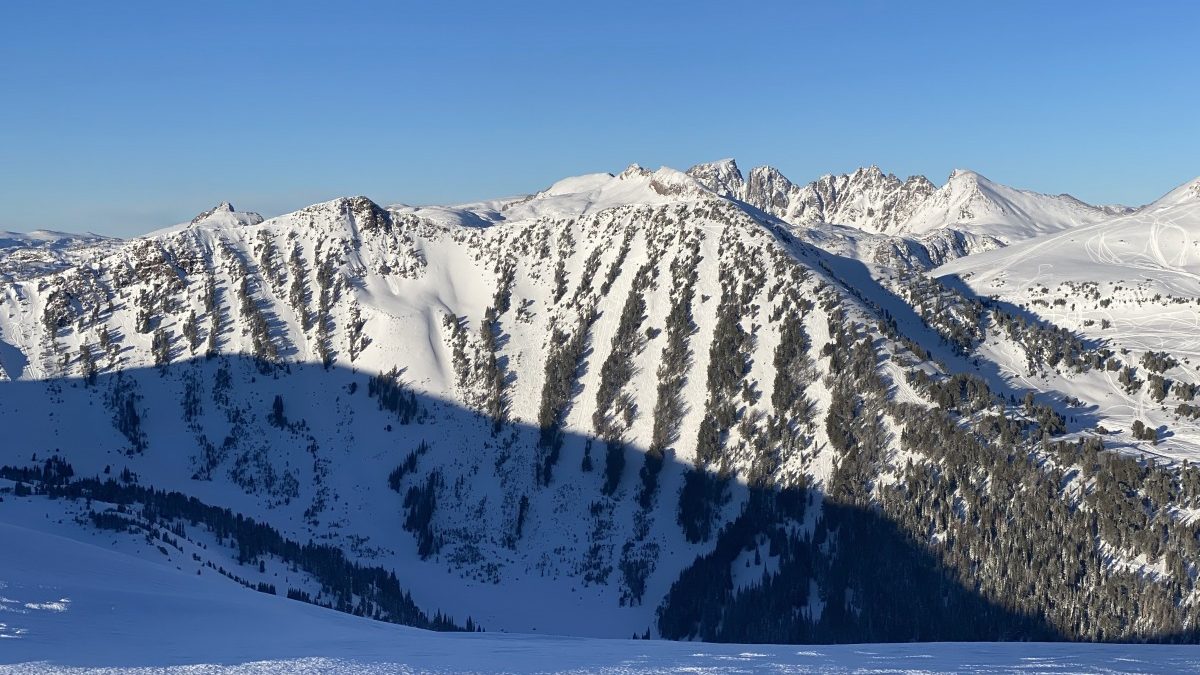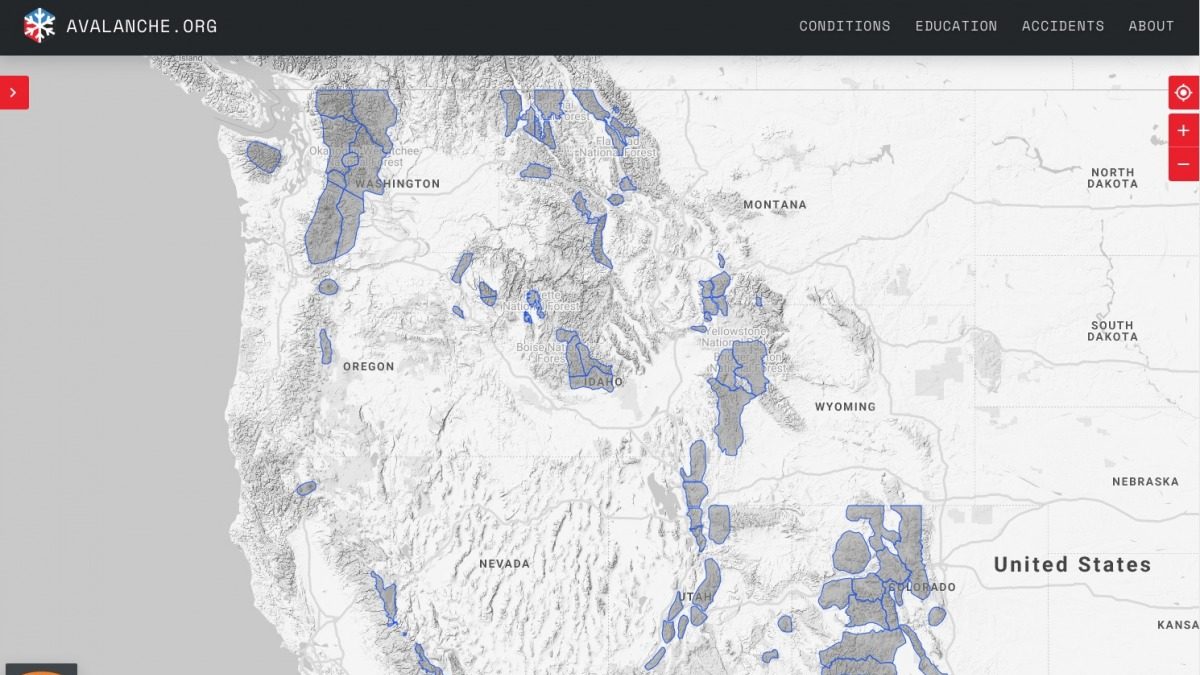
This photo, captured by Julia Dubinina near Cooke City, Montana offers an excellent view of complex mountain terrain.
For years, WildSnow has been in the business of providing practical information in terms of backcountry travel. Specifically, we have featured an array of resources on avalanche education and safety.
With the earth tilting past the equinox, the Northern Hemisphere is trending towards the less-sunlight part of the year. So it’s time to brush up on your avy basics, or, if you are new to the sport, start thinking about the first steps.
Step one: The One Stop Shop — Avalanche Education Resources
Last season, we compiled a thorough list of educational resources (linked above) spanning from never-evers (as never before backcountry skied) to those more experienced.
Here are several databases to find an appropriate avalanche course in your region. We should note that since Covid, many course providers have created online modules for in-person classes. In other words, what once may have been an in-person class in its entirety, has evolved to include some online class time.
American Avalanche Institute (AAI) Courses for 2021-2022 listed by state/international.
AAI Current online courses. These offerings range from stand-alone courses to online modules for hybrid courses featuring both an online and in-person component.
Avalanche Canada course database. If you are coming to WildSnow from Canada, this database will get you started looking for an avalanche class.
Online comprehensive educational tools:
Mark Smiley, an IFMGA Certified Mountain Guide, has created a menu of online-only classes at Mountain Sense. Two of which are specific to avalanche safety: A Comprehensive Guide to Avalanche Safety – be a savvy & desirable backcountry partner, and a new product, Beyond Level One – backcountry ski touring decisions in the real world.
Another note about courses, the pathway for skiers to progress from intro level curriculum to more advanced work, can be confusing. Levels of Avalanche Education Courses Explained, a previously published WildSnow article, demystifies the avy course progression.
Learning from Guides
Hiring a guide in Europe is as common as stashing a baguette and Brie in the pack for a tasty mid-skin snack. Here in the U.S., hiring a guide is becoming increasingly more common. If you are waffling about hiring a guide, mountain guide Jed Porter penned this excellent resource on why hiring a guide might be in your self-interest and be more fun: The Masses Speak -Why to Hire a Guide this Winter.
Most ski guides also provide the gift of simply spending the day ski-touring. These experiences include real-world decision making and snow and terrain assessment. Have no fear; you’ll be skinning and making turns too.
Places to start looking for a certified guide in the U.S.:
American Mountain Guides Association (AMGA).
Suppose you are based outside the U.S. or traveling abroad and would like to connect with a guide. In that case, this database of International Federation of Mountain Guides Associations (IFMGA) member associations is comprehensive.
Forecast Centers
No matter where you fall on the experience spectrum, familiarizing yourself with local and regional avalanche forecast centers is invaluable. Here’s avalanche.org’s list of U.S. centers.
Remaining on topic, avalanche.org, the website for A3, also features an interactive forecast map on its homepage. There, you’ll be able to click on a specific forecast for your region. Use this as one tool, not the tool, to base all your decisions. (But you know that already.) Checking the forecast is an easy first step in the AM to glean information. On the avalanche.org interactive map, each region links to a specific avy forecast. From there, you’ll see a “get more information” button; click there to get the detailed information for the day. This map is also a tool to get a general idea of avalanche conditions region-wide. The map is color-coded from green to yellow, orange, red, and black: green meaning low danger, and black, extreme.

This screenshot of the avalanche.org homepage shows a macro-view of some avalanche forecast regions in the western U.S.
You can find a similar interface on the Avalanche Canada site. As a one-stop site for data collection, it is savvy. Scroll in (magnify the map), and specific links to avalanche forecasts become available. Additionally, the map includes links to weather stations and red pin drops linking to avalanche incidents involving a fatality.
Both of the interfaces mentioned in this section are macro-level tools linking through to more specific information.
On the WildSnow website, you can find a selection of articles exploring the world of forecasting. One that comes to mind is “Avalanche Forecasting 101 — A Conversation with Blase Reardon“. Reardon is the director of the Flathead Avalanche Center in Northwest Montana, and there are some gold nuggets in the interview like this exchange:
WS: On the subject of the danger scale, I’m curious about orange and yellow and the fact that more reported incidents occur in that range. Do you think that is working as far as distinctive layers on the danger scale?
BR: That’s a good question. One of the things that some studies are starting to show is that forecasters and the public view the danger scale differently. For forecasters, the scale is an exponential curve. Danger goes up exponentially as the ratings go up. But for a lot of people who aren’t forecasters, it’s a linear thing.
Using the Forecast
We’re going to beat the cautionary drum. A forecast, in this context, is a prediction of an event’s likelihood. Consider a forecast a valuable tool when deciding where and when to ski/ride — not a definitive tool. The mountains are an unpredictable environment. That’s our disclaimer.
Initially, avalanche forecasts can seem daunting and laced with sport-specific jargon. The Utah Avalanche Center published a handy tutorial on reading and interpreting avalanche forecasts. The tutorial provides links to resources that help translate forecasts. This resource provides in-depth material on danger ratings, the “danger rose”, and typical avalanche problems.
The Utah Avalanche Center’s video on the danger rose is one example from their extensive youtube channel.
In terms of using the forecast, WildSnow ran a story titled “Using the Avalanche Forecast for the Trip Planning” this past April. The piece lays out one perspective of systematically planning a ski tour based on a forecast. Two reader comments from the “Using the Avalanche Forecast” story also highlight some solid points.
“Planning is great, but be flexible and practice backing off.” – Mike Marlot
“Having a repeatable decision making process and debrief is simply a way to up your chances of coming home and continue the lifelong learning game. Getting an expert opinion from the forecast center is a good place to start.” – Tom Murphy
We’ll follow up this fall with more on avalanche resources geared towards making more informed decisions in the backcountry.
Jason Albert comes to WildSnow from Bend, Oregon. After growing up on the East Coast, he migrated from Montana to Colorado and settled in Oregon. Simple pleasures are quiet and long days touring. His gray hair might stem from his first Grand Traverse in 2000 when rented leather boots and 210cm skis were not the speed weapons he had hoped for. Jason survived the transition from free-heel kool-aid drinker to faster and lighter (think AT), and safer, are better.
